'Vulture' is the common name for carrion-eating birds. There are two varieties ... the American and the Eurasian/African vulture. There are many differing species within each group, but all vultures are large birds with a naked head and hooked bill. They feed almost entirely on dead animals, but will occasionally attack newborn or wounded living animals. Most vultures hunt by sight, soaring high in the sky, and descending to feed. 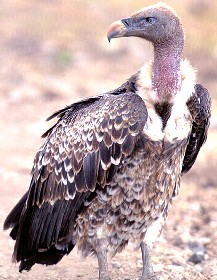 The Griffon Vulture is the Eurasian/African variety, and can be found in countries around the Mediterranean, as far east as India, and throughout the savannas of Africa.
It weighs about 7 kilograms, and has a two-and-a-half metre wingspan. Unlike raptors, however, it has only short legs with weak, blunt toes.
The Griffon Vulture is the Eurasian/African variety, and can be found in countries around the Mediterranean, as far east as India, and throughout the savannas of Africa.
It weighs about 7 kilograms, and has a two-and-a-half metre wingspan. Unlike raptors, however, it has only short legs with weak, blunt toes.Its beak is short with a down-curving pointed end; its long neck is thinly covered with down with a collar of feathers at the base. The Griffon vulture feeds mostly on large dead mammals. When it finds a carcass, it will eat primarily the muscle meat and viscera. The vulture's crop and gizzard can hold over 6 kg of meat at once. Vultures lay one egg each mating period; the babies are covered with pale brown down, but start to resemble an adult vulture after 3-4 months. The life span of a Griffon vulture is thought to be about 40 years. 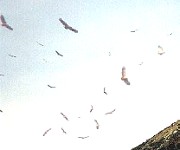 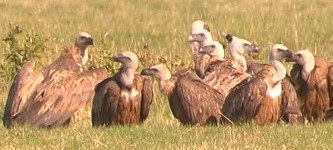 Unlike American vultures that rely on a sense of smell, Griffon vultures use their keen eyesight to search for food ... a rotting carcass, or perhaps just other vultures circling a meal they've found. Because they get very bloody when eating, they like to keep clean ... dozens of griffon vultures gather by pools of water to bathe, and then stand with wings extended to dry out. 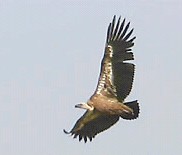 The Griffon vulture can only fly well in warm weather, and relies on upward-moving air currents to help it keep aloft. But a vulture's body is built for soaring flight, and it may cruise for 6 or 7 hours and to distances of over 50 kilometres, looking for food.
The Griffon vulture can only fly well in warm weather, and relies on upward-moving air currents to help it keep aloft. But a vulture's body is built for soaring flight, and it may cruise for 6 or 7 hours and to distances of over 50 kilometres, looking for food.When one vulture finds a carcass, others see it and congregate. Many vultures may circle above, waiting around a kill for a chance to feed. The Griffon vulture's beak is not very strong, so it must also wait for other smaller vultures, or animals, to tear the carcass open, before it can itself eat. 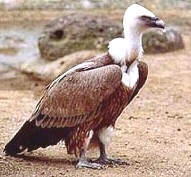 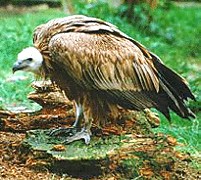 Populations of vultures are declining in many places, and particularly in Africa, due to loss of habitat and persecution by humans. However, there are efforts underway in many countries to help bring back the Griffon vulture population. |